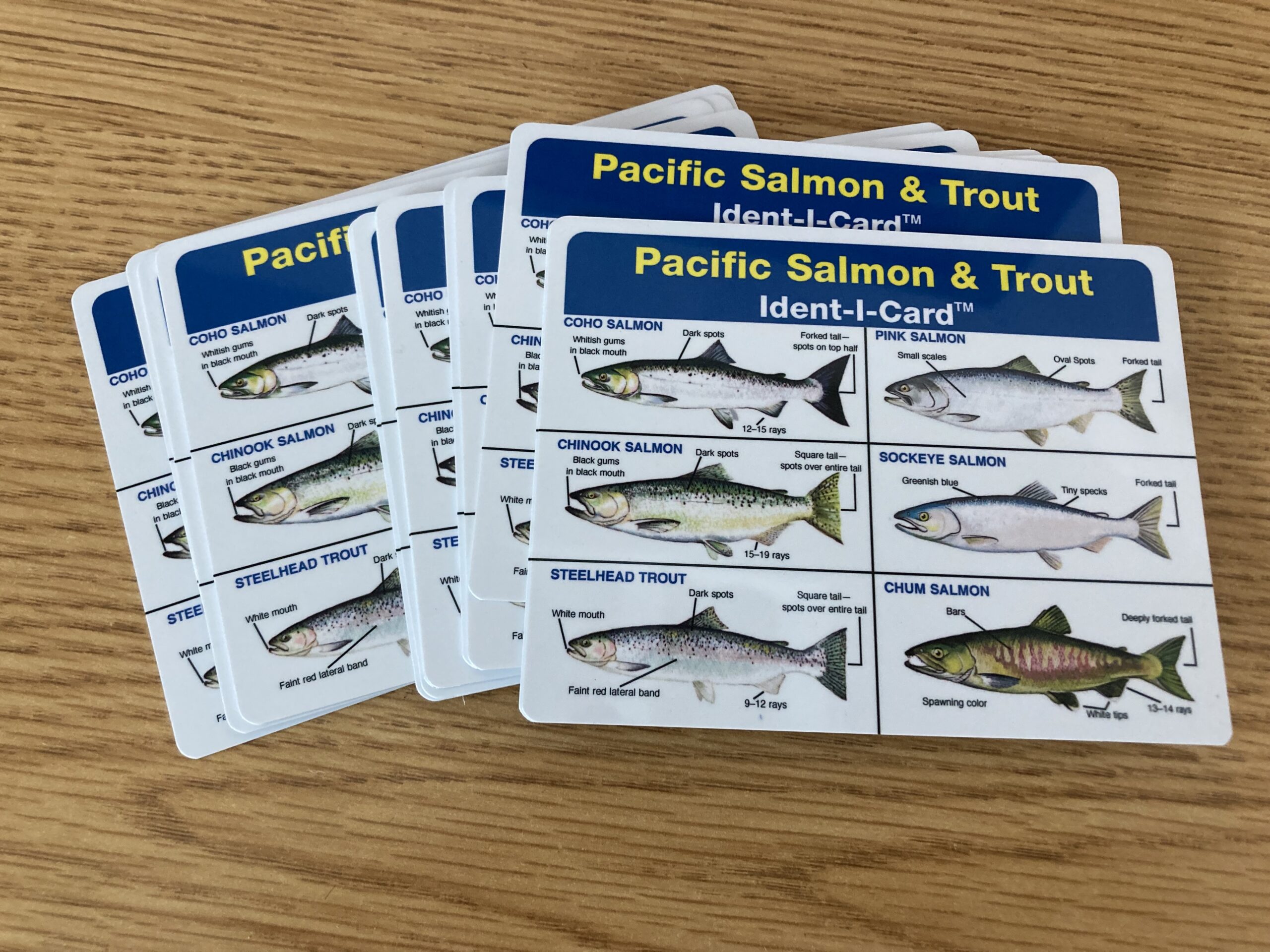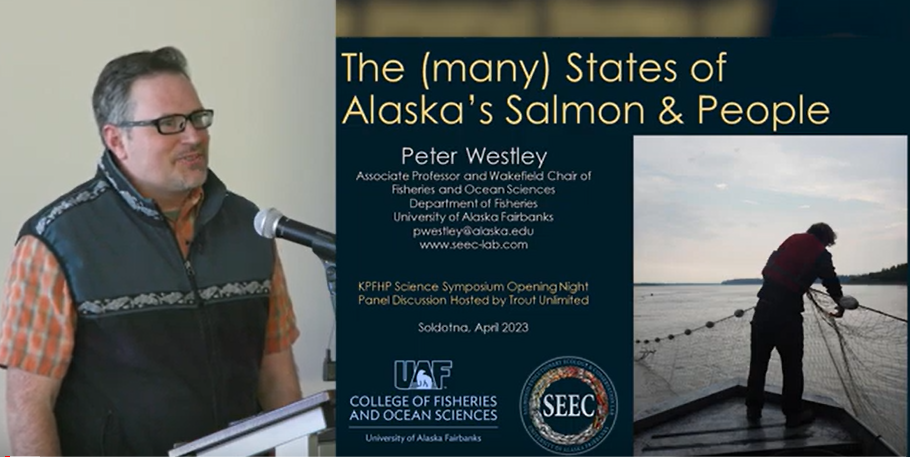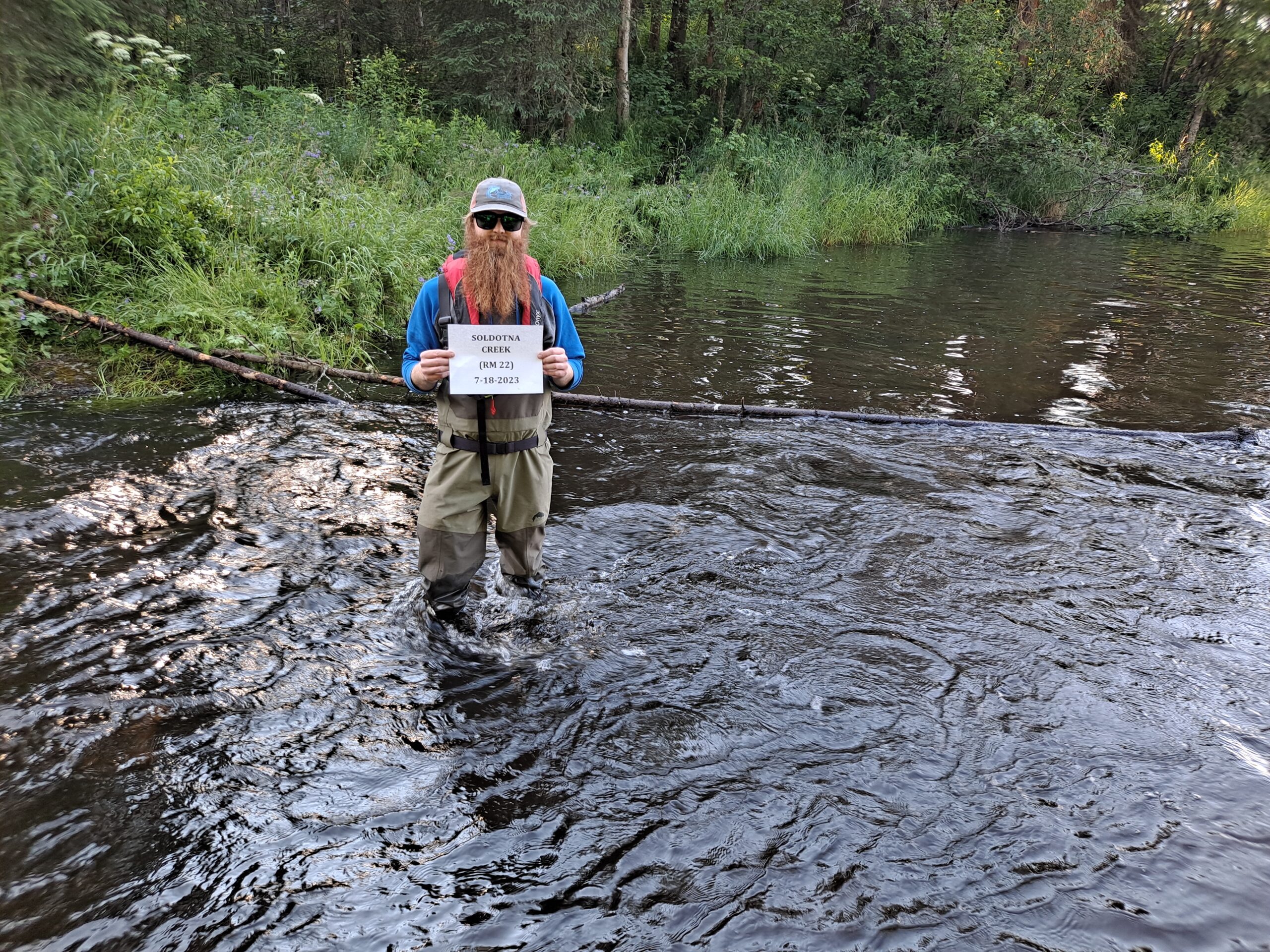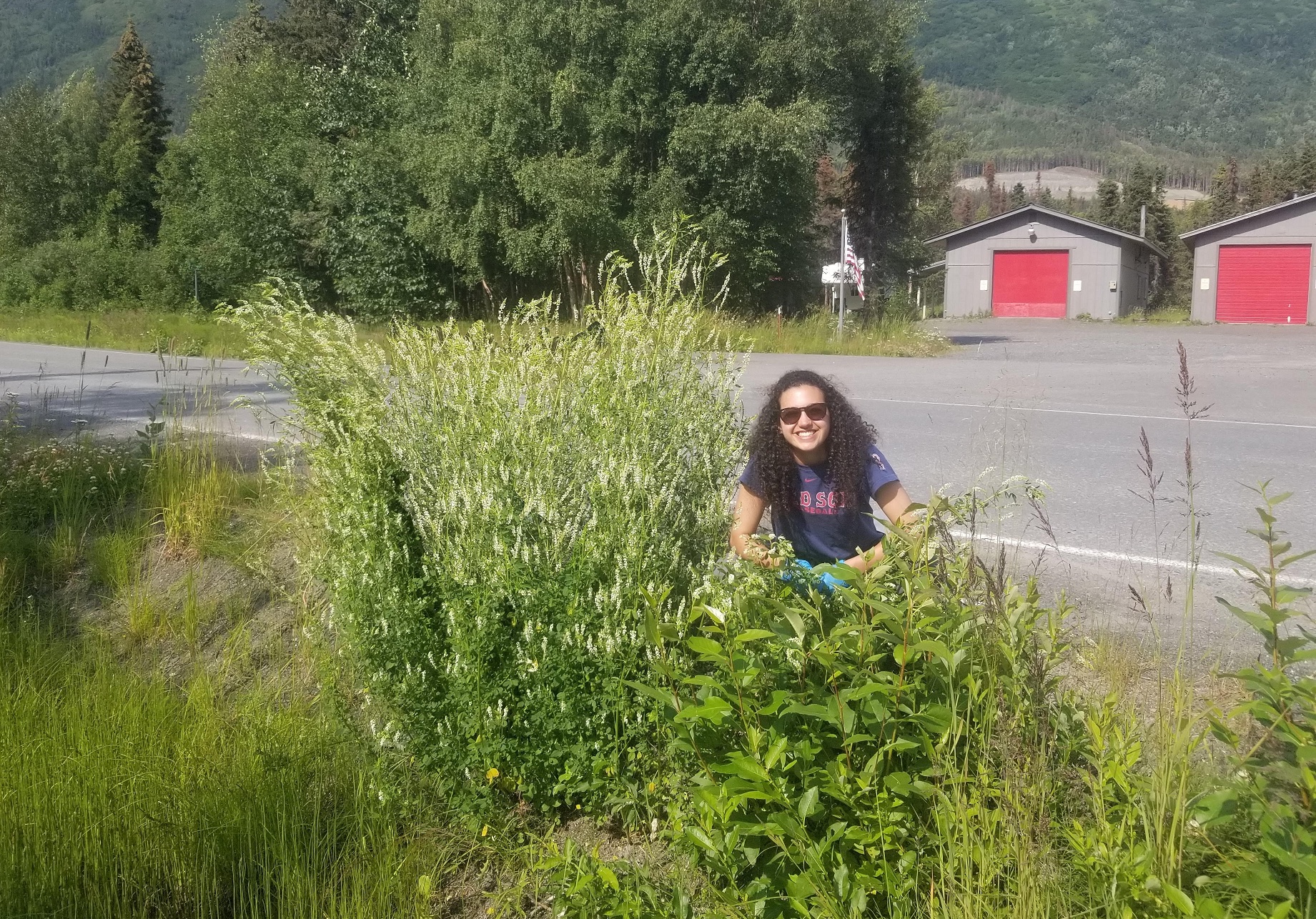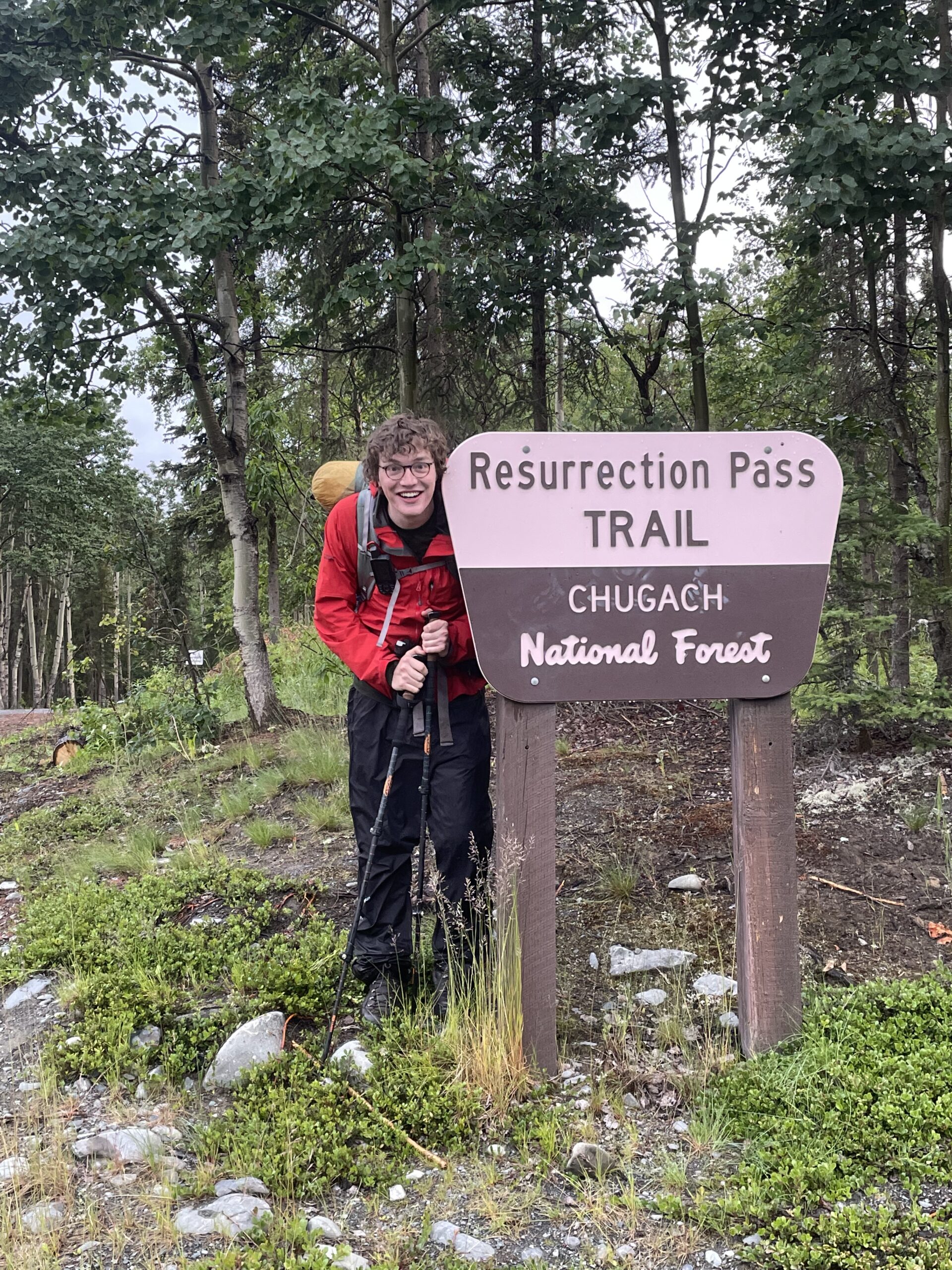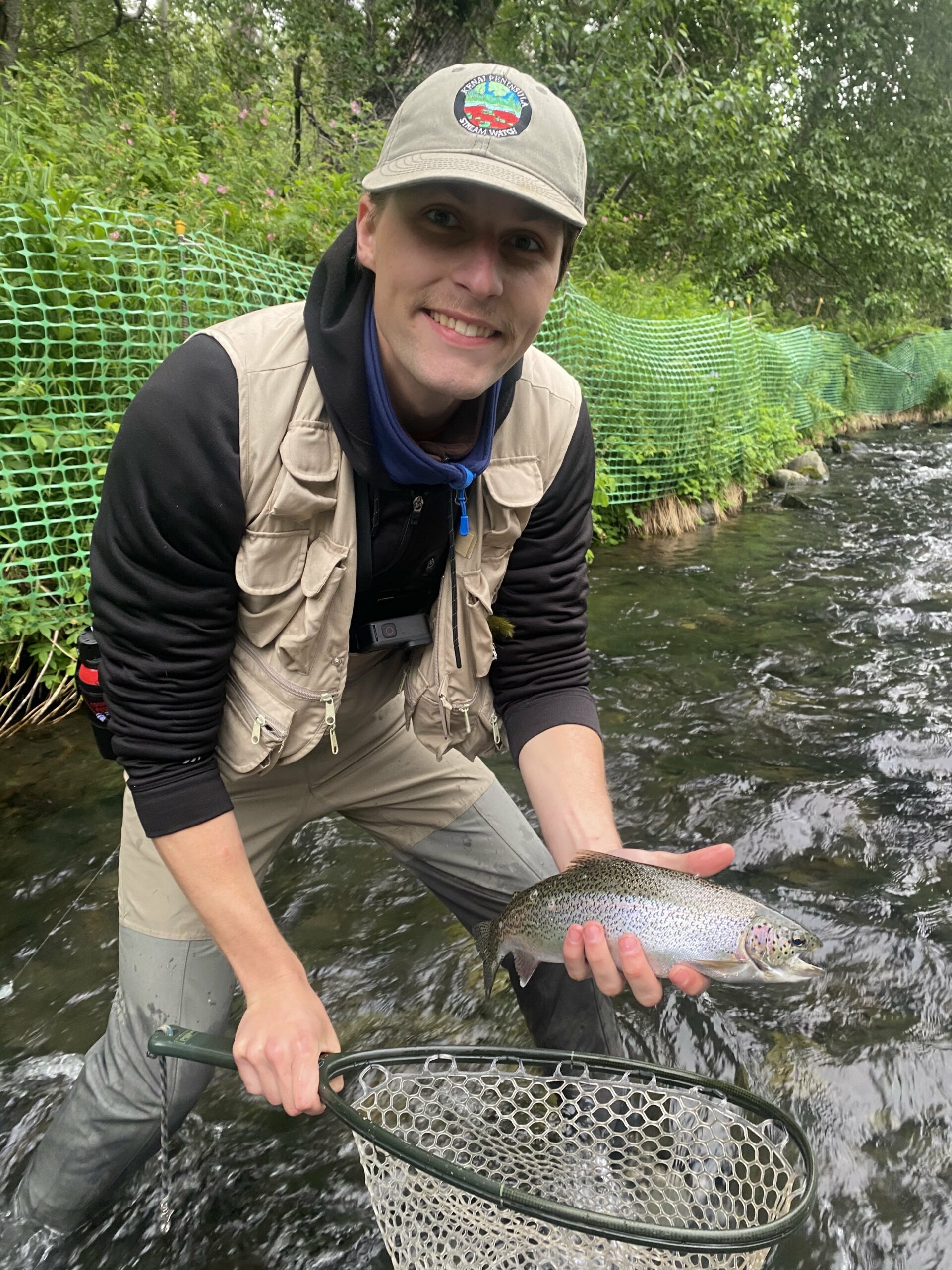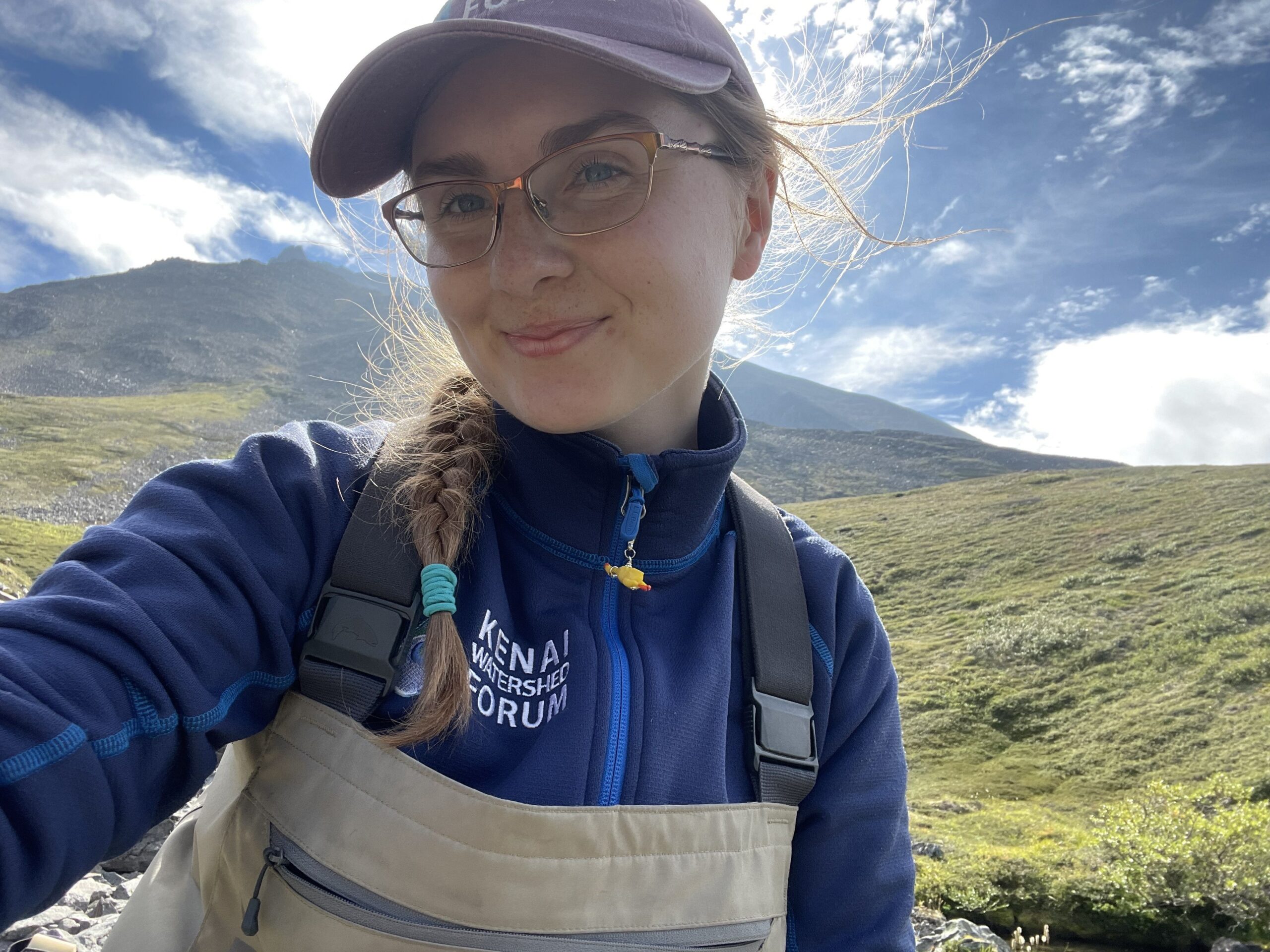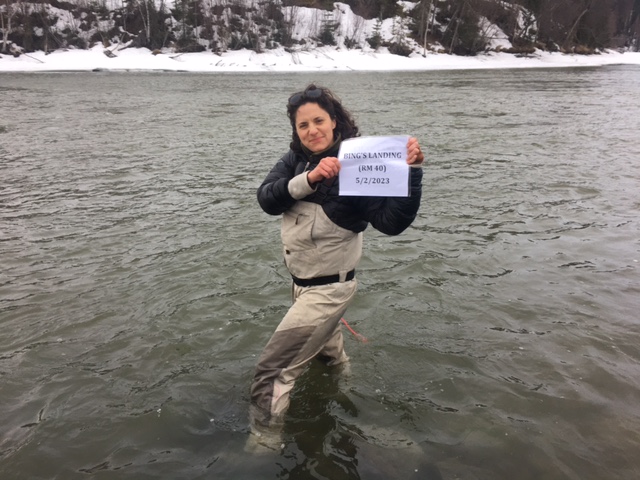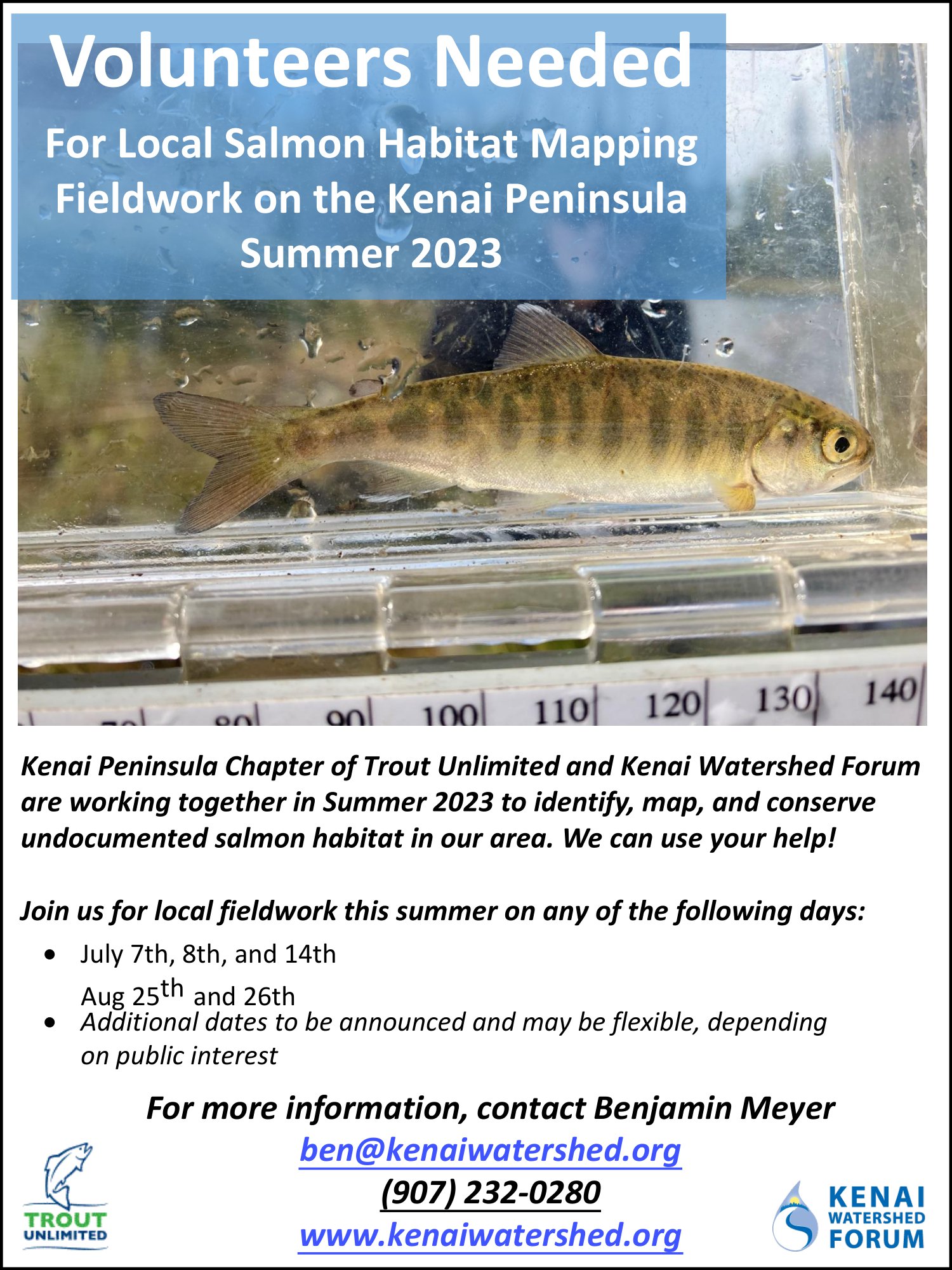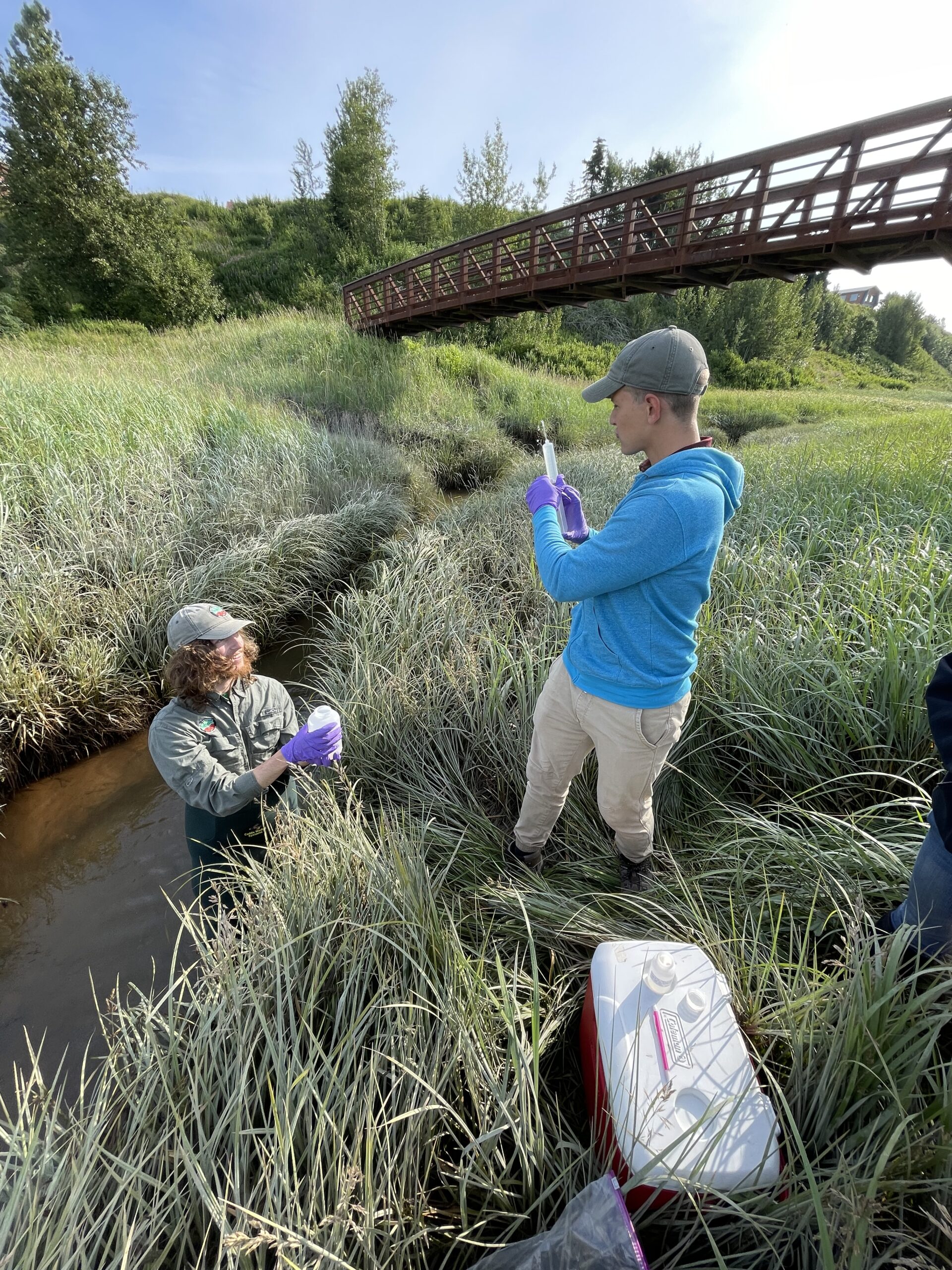What’s that salmon species?
March 12, 2024Come pick up your free Identicard at our office (44129 Sterling Hwy) today!
Here at Kenai Watershed Forum it’s that time of the year again to prepare for teaching at the annual Kenai River Guide Academy (www.krga.org). The five-day academy is a required training for all new guides working on the Kenai River, and covers topics from boating regulations to caring for one’s catch and more.
For the last several years, KWF board member Dr. David Wartinbee and KWF Environmental Scientist Benjamin Meyer have co-taught a section on stream ecology and the salmon lifecycle. You can watch a series of recorded lectures form this training for free on our YouTube channel.
Before any Alaskan fisherman picks up a pole or net, they should be intimately familiar with how to ID all species of Pacific salmon. As a handy reference, we recommend downloading the printouts below to your phone. Or, stop by our office (44129 Sterling Hwy, by Soldotna Creek park) any time to pick up a free handy waterproof Ident-i-Card, which will help new fisherman quickly learn species ID.
See you out on the river!
Click to Download Salmon ID Page
Click to Download Salmon ID Flowchart
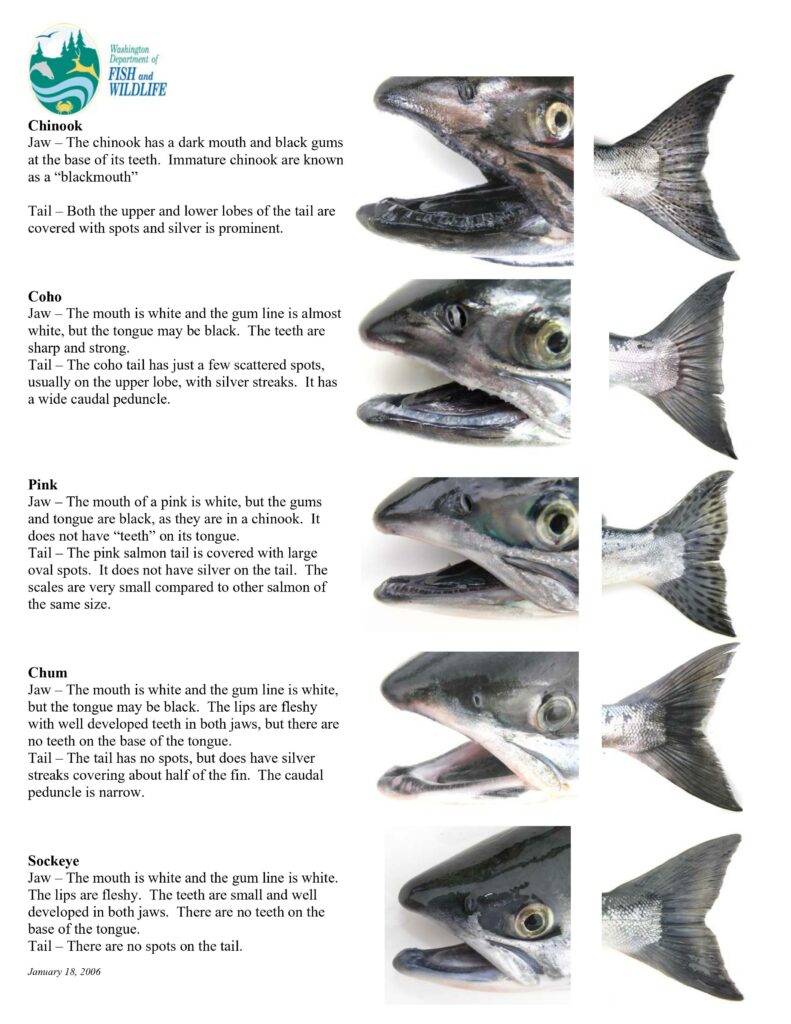
Image courtesy Washington Dept. of Fish and Wildlife
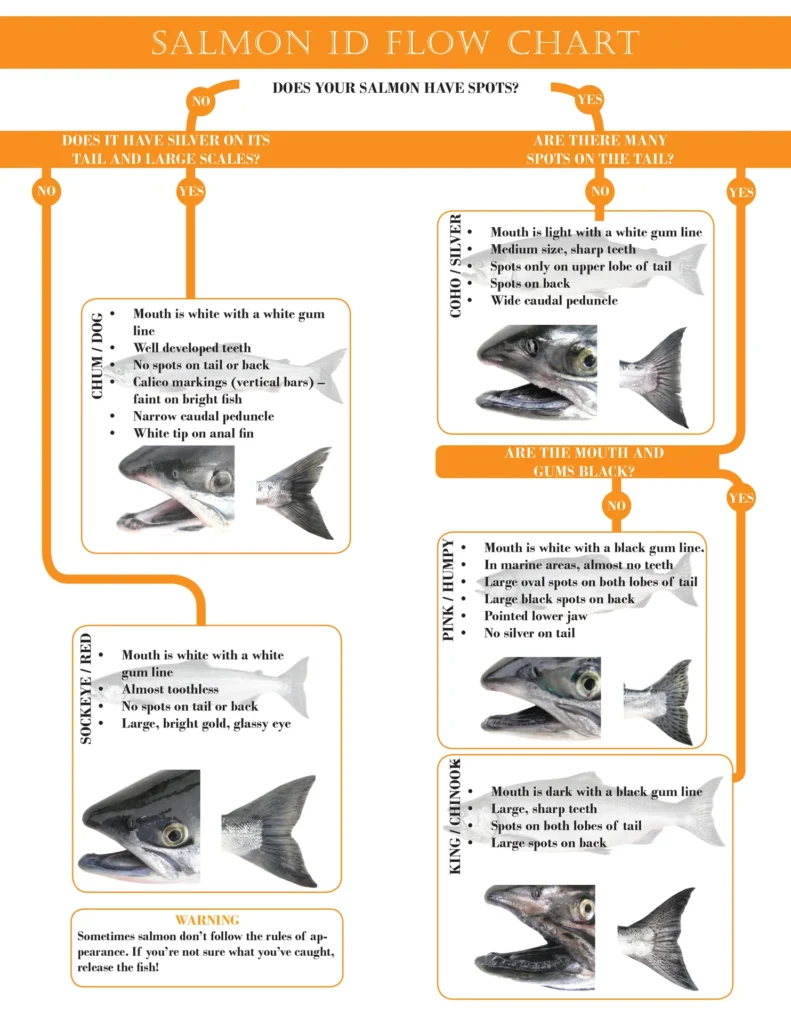
Flowchart courtesy washingtonflyfishing.com
In Case You Missed It: The Many States of Alaska’s Salmon and People
January 16, 2024How are Alaska’s salmon doing? There is no one single answer to this question, but rather many.
In April 2023, we were joined for an insightful lecture on the state of Alaska’s salmon and people from University of Alaska Fairbanks Fisheries Professor Dr. Peter Westley. In this video, Peter takes us on a compelling thirty minute tour of Alaska’s wild salmon and the people who rely on them today. Why are Bristol Bay Sockeye Salmon runs setting all-time records while King Salmon runs around the state struggle? What opportunities and threats are on the horizon? What can people control about wild salmon, and what can’t we control?
Check out the video below to learn more!
Summer 2023 Kenai River Water Quality Sampling Results Available
November 1, 2023Kenai Watershed Forum has received all laboratory results from it’s Summer 2023 Baseline Water Quality Monitoring. The results are currently being prepared for upload to the Environmental Protection Agency’s Water Quality Exchange, a pubic data repository for water quality data.
Once the data is prepared, it will be integrated into an in-progress comprehensive summary report, similar to our previous such report published in 2016.
The results are preliminary have not yet been subject to QA/QC checks or analyzed against water quality standards; we expect to complete this by Winter 2024.
We worked with two laboratories in Summer 2023:
1.) Soldotna Wastewater Treatment Plant – SWWTP provided analyses of Total Suspended Solids and Fecal Coliform:
Download Summer 2023 Total Suspended Solids results
Download Summer 2023 Fecal Coliform results
2.) SGS Laboratories, Anchorage – SGS provided analyses of all other substances monitored in Summer 2023, including nutrients like phosphorus and nitrogen, and metals like zinc, copper, lead, and others:
Download Summer 2023 Metals and Nutrients results
For questions about 2023 water quality results, contact Benjamin Meyer, Water Quality Coordinator. Thank you again to all the participants and volunteers who made this event happen!
Victoria Eisenberg (Summer 2023)
September 1, 2023Being part of an organization that enacts meaningful environmental change is something that I couldn’t be more proud of. At KWF, I’ve had the opportunity to work in various fields of environmental conservation. From teaching kids about salmon life cycles at summer camp to sampling the water that those salmon run through, I’ve been able to see each and every step that this organization takes to preserve the Kenai Watershed.
With the admirable goal of keeping the watershed healthy, it’s not hard to believe that the people at KWF are just as wonderful as the work we strive to achieve. From the very start of the hiring process, everyone here has been warm, welcoming, and understanding. Even on the (rare) days that we’re stuck inside, there’s always light and livelihood to be found in this office.
Since the beginning of my internship at KWF, I’d been told that the Kenai River Festival, a river conservation awareness festival that KWF hosts annually, would be an untamable beast of an event that would unapologetically hurl me into my time here. While I appreciated the dramatics, I didn’t necessarily believe that it would be all that crazy–obviously, I was wrong. It was a very chaotic weekend, indeed, and I ran around like a headless chicken for the majority of the time. I rarely stopped to take it all in but, when I did, I realized the incredible impact we were making. There were tents teaching about fishing safety, kids painting salmon, and adults learning about local invasive species. Not only did we bring our community together, but we also came together as a team; it was gratifying to say the least. By the end of the festival, every one of us was absolutely exhausted, but it was clear that each person felt proud and accomplished to have been a part of it all–it was certainly a job well done. As lawless as that weekend was, I can say with certainty that it was one of my favorites of the summer.
These past few months at KWF have been some of the best of my life. I’ve had the incredible opportunity to work towards something I’m passionate about with people who make it a pleasure to do so (plus having some pretty awesome weekends in the mountains). Coming to Alaska and working with the Kenai Watershed Forum has truly been a dream come true, and I’m beyond grateful to everyone here for making my experience one for the books.
Finn Newman (Summer 2023)
September 1, 2023My time at KWF started with the ritual Costco trip and then the long ride from Anchorage to Soldotna. Though that memory is a blur for me at this point, I remember staring out the window in awe as the Chugach mountains and Kenai River flashed in the window of the Red Tacoma. My experience with the Stream Watch program and the Kenai Watershed Forum was extremely eye-opening and opened the door for many amazing adventures and career opportunities.
The most memorable day for me was our second day in Alaska, when Matt, Brandon, and I went to the Russian River campground and put up habitat fencing along the river. It was a beautiful day, with blue skies, snow still on the mountains, and the campground deserted. Meeting everyone in the Pink Salmon parking area, I knew that everyone had a deep, deep love for the river and the fish that call the river home, and I knew I was in good hands.
The rest of the summer has been an absolute blast. Every day at work was something new and exciting, from working with our amazing, dedicated volunteers, to restoring the bank of Soldotna Creek. I loved working with the summer camp, trapping baby salmon to discover unmapped salmon habitat, working with the Forest Service at the Russian River, and connecting with new, amazing people every day. Stream Watch gives you the opportunity to meet every kind of person who comes to enjoy the river, including anglers, hikers, bear researchers, photographers, hunters, and guides. The people I’ve met through this internship are some of the most inspiring I have ever met. This internship allowed me to get a fuller picture of Alaska and the Kenai Peninsula than I could have at any other organization. I engaged with all sorts of stakeholders and user groups to work out how to best manage the river, connected with people to let them know the regulations, and educated visitors on the importance of healthy rivers. Stream Watch provides an invaluable service, connecting people with the land and river through stewardship and volunteering for the good of the ecosystem. I’m extremely proud to have been part of Stream Watch and of the work we did for the peninsula! The difference that Stream Watch makes is truly inspiring. It is a perfect example of what can come from people who care for and are concerned about the health of a river, and I hope to see more like Stream Watch elsewhere in the future.
In my time off, I backpacked from Hope to Cooper Landing (40 miles!), hiked to an abandoned military fort on Resurrection Bay (Caines Head), crossed a glacial outflow on a hand tram (Grewingk Glacier), and caught sockeye salmon out of the Russian River, among many, many other hijinks. Everyone at KWF was happy to assist in planning trips, giving advice, and even lending equipment. I’ve been extremely lucky to work somewhere that cares so much for all of their employees and seasonal staff, and I would definitely love to come back to the peninsula and to KWF.
Matthew Maguire (Summer 2023)
September 1, 2023The time I’ve spent with the Kenai Watershed Forum has been one of the most eye–opening experiences of my life. I came to Alaska to gain a better understanding of fisheries management while also trying to grow my professional network and resume. The Stream Watch program provided me with all of those opportunities.
KWF was full of surprises. I was able to spend some time helping with water quality sampling, fish trapping (and fishing at the sites), as well as spending time working with KWF’s summer camp. All of these experiences introduced me to many different career avenues that I hope will help me professionally.
The Kenai Peninsula has become one of my favorite places on the planet. My first day of work was spent on the Russian River and I immediately fell in love with the fiddlehead ferns and massive rainbow trout.
I regretfully have to go back to school but, to the future interns and visitors, prepared for one of the best summers of your life.
Katrina Danzinger (Summer 2023)
September 1, 2023Since I’ve started at the Kenai Watershed Forum, I’ve met hard working coworkers, passionate volunteers, new friends, and created lasting memories. Living in Alaska has provided me with an experience that fuels my interests in conservation and restoration while actually presenting opportunities to make a difference. As an environmental science intern, my daily activities varied greatly from day to day. Hopping from one project to another – even in the same day – is part of the enjoyment of a workplace like this. One such instance is the field work I’ve done on the salmon habitat mapping project.
In the salmon habitat mapping project, we used minnow traps to capture, identify, and release the juvenile fish in local streams. Areas of interest can include culverts at ends of previously documented streams and lakes, as well as undocumented bodies of water. Enough salmonids caught can provide sufficient documentation of a stream or lake to be classified as salmon-bearing, or “anadromous”. During the time that I’ve been at the Watershed Forum, we’ve been able to gather evidence for over three miles of new anadromous waters on the Kenai Peninsula. This work is meaningful to me, because I know that I am providing for a community that is mindful of their impact towards salmon habitat.
Although days as a watershed intern were full, there were still weekends to get out and explore what Alaska has to offer. There were many places to traverse on the peninsula to fill a weekend – from pack rafting near Swan Lake, fishing in the Kasilof river, and hiking at Caines Head – I never had trouble finding something to do! Fair warning to those coming in the future – be prepared, you just might not want to leave.
Spring 2023 Kenai River Water Quality Sampling Results Available
July 26, 2023Kenai Watershed Forum has received all laboratory results from it’s Spring 2023 Baseline Water Quality Monitoring. The results are currently being prepared for upload to the Environmental Protection Agency’s Water Quality Exchange, a pubic data repository for water quality data.
The results are preliminary have not yet been subject to QA/QC checks or analyzed against water quality standards; we expect to complete this by Winter 2024.
We worked with two laboratories in Spring 2023:
1.) Soldotna Wastewater Treatment Plant – SWWTP provided analyses of Total Suspended Solids and Fecal Coliform:
Download Spring 2023 Total Suspended Solids results
Download Spring 2023 Fecal Coliform results
2.) SGS Laboratories, Anchorage – SGS provided analyses of all other substances monitored in Spring 2023, including nutrients like phosphorus and nitrogen, and metals like zinc, copper, lead, and others:
Download Spring 2023 Metals and Nutrients results
For questions about 2023 water quality results, contact Benjamin Meyer, Water Quality Coordinator. Thank you again to all the participants and volunteers who made this event happen!
Volunteers Needed for Salmon Habitat Mapping Research
May 25, 2023Kenai Peninsula Chapter of Trout Unlimited is partnering with Kenai Watershed Forum in summer 2023 to identify, map, and conserve undocumented salmon habitat in our area. We can use your help!
Join us for local fieldwork this summer. For dates and more information, contact Benjamin Meyer (Water Quality Coordinator) at ben@kenaiwatershed.org.
Quality Assurance Project Plan revisions completed
May 9, 2023The foundation of a long-term water quality monitoring program like Kenai Watershed Forum’s Kenai River Baseline Monitoring is a good Quality Assurance Project Plan, or QAPP. The QAPP outlines technical details when it comes to who, what, when, and where of a water quality monitoring project. It is an instruction manual and checklist, an accountability document and a reference guide. Maintaining an up-to-date QAPP is important to ensure we are using the best-available science.
With support from the Bureau of Reclamation WaterSMART Cooperative Watershed Management Program, Kenai Watershed Forum recently completed an update of our QAPP, the document which guides our water quality monitoring work. Our thanks to staff at the Region 10 EPA office as well as the Alaska Department of Environmental Conservation who provided feedback and comments.
Our current QAPP is linked below and available to download. Please contact us if you have questions about the QAPP, or about QAPP development in general.
Download Kenai Watershed Forum’s 2023 Quality Assurance Project Plan (QAPP)
***
Bonus Content
- Download the “Work Group Notebook” from 1997 that records the efforts of local agencies, nonprofits, landowners, and academics coming together to design the Kenai River Baseline Monitoring program, which has been in operation from the year 2000 – present.
- Watch a 10-minute presentation on our YouTube channel about our Kenai River Baseline Monitoring program
